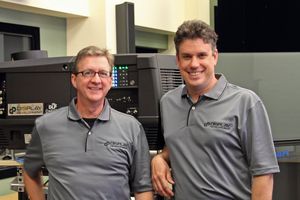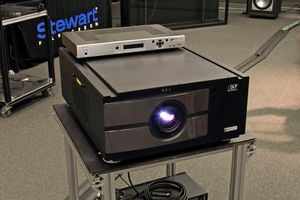A Brighter Idea
This is not just another new video projection company. At least, that's the impression I got after hearing the pitch for Display Development, a firm founded by projection-industry veterans Jim Burns and Pat Bradley. When the two showed off a few of their new creations in the training room at Stewart Filmscreen in Torrance, Calif., today, they had a lot more to say than just, "We're better than everybody else." In fact, they specifically addressed a need that - in my opinion - the industry has largely ignored: the desire for a brighter picture.
 Since the early days of home theater, the industry has focused on making projectors look good in a dark room, where an image brightness of, say, 16 footlamberts is perfectly OK. And it's not just a problem for home viewers - there's some evidence that even cinema projectionists have been settling for substandard light output.
Since the early days of home theater, the industry has focused on making projectors look good in a dark room, where an image brightness of, say, 16 footlamberts is perfectly OK. And it's not just a problem for home viewers - there's some evidence that even cinema projectionists have been settling for substandard light output.
But, according to Burns, "A lot of people's idea of a good picture is 40 to 60 footlamberts." In other words, the kind of output you might get from a good flat-panel TV set - an image bright enough to look pretty good even when the room lights are on.
To that end, the company is creating projection systems that can deliver good pictures in practically any indoor situation. What's more, they can do it even at humongous picture sizes. At the Stewart demo (which of course featured Stewart screens as well as a Wisdom Audio sound system), Display Development's $97,000 Digital Film 3 (or DF3) projector delivered an 11 1/2-foot-wide picture at an astounding 103 footlamberts. When Bradley put up a 100 IRE (maximum brightness) white field, it was so bright I could barely stand to look at the screen. And at this brightness, the picture still had decent contrast - even with all the room lights on.
 Display Development is offering three projector lines. At the bottom is the HD line, which starts at $20,000 and uses a projector chassis designed for residential use. Next is the Digital Film line, which uses a digital cinema projector chassis. Topping out at $360,000 is the Reference line, which employs a 2K or 4K digital cinema chassis. All projectors include a lens and a separate eight-input video scaler.
Display Development is offering three projector lines. At the bottom is the HD line, which starts at $20,000 and uses a projector chassis designed for residential use. Next is the Digital Film line, which uses a digital cinema projector chassis. Topping out at $360,000 is the Reference line, which employs a 2K or 4K digital cinema chassis. All projectors include a lens and a separate eight-input video scaler.
Burns summed it up well when he said, "We're offering a TV experience and a film experience."
- Brent Butterworth
- Log in or register to post comments





























































